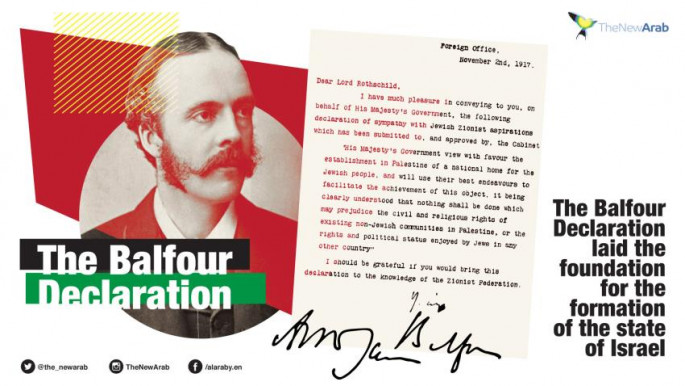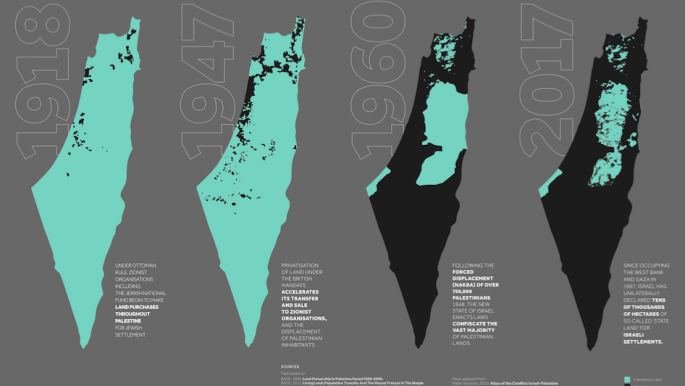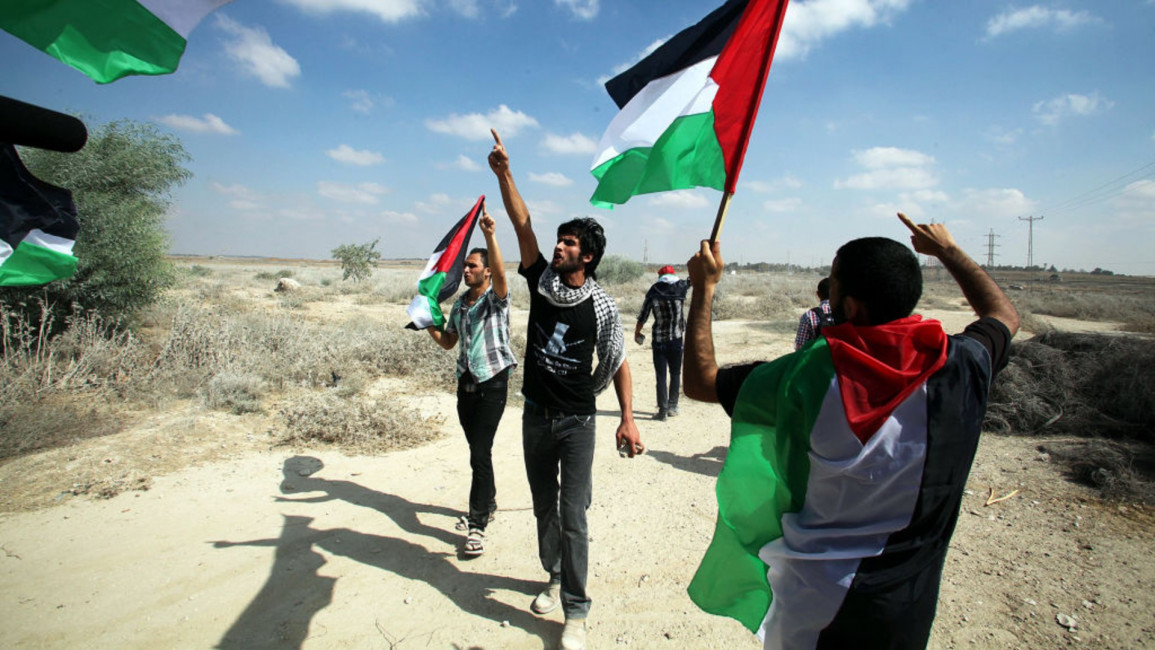
Palestine: A history punctuated by the intifadas
In the 1920s, the Palestinians staged many revolts against the Jewish colonies. One of the most important was the "Buraq revolt" referring to the West Wall of the Al-Aqsa mosque, which Muslims call the "Buraq Wall" and Jews "the Wailing Wall".
This was an uprising in reaction to an attempted appropriation of the wall by the Jews who were no longer satisfied with the right to visit and pray there.
Unlike previous revolts, this one spread to most Palestinian cities and villages and even a number of Jewish colonies. The British had considerable difficulty putting down the violence, with intensive use of aircraft and armoured vehicles, and by calling in units based in other countries.
The great revolt of 1936-1939
Following this uprising, the Palestinian struggle targeted the British occupation system rather than the Zionist settlements (the Yishuv). The leadership of the national Palestinian movements had lost all hope that the British would give up their plans for a "Jewish national homeland" as stated in the Balfour Declaration.
As a result, several Palestinians cities, including Jerusalem and Jaffa were the scene of rebellions against British rule, protesting their failure to react to the arming of Zionist organisations, and continued Jewish immigration to Palestine.
These protests, as well as the massive demonstration of 21 November 1935 in Haifa, resulted a general strike on 20 April 1936, called by the National Committee in Nablus. The movement was also in response to the murder in Jaffa of four Palestinians, including a woman, by Jewish colonisers, and this was the start of the 1936-39 revolt.
For fear that leadership of the general strike might fall into the hands of the local grassroots committees and cause it to be sidelined, the heads of the Palestinian political parties met on 25 April 1936 and announced the creation of an Arab Higher Committee, presided over by the Mufti of Jerusalem, Mohamed Amine al-Husseini.
 |
What distinguished that First Intifada was its grassroots and democratic nature |  |
The committee called for a continuation of the general strike until the British authorities accepted the demands of the Arab National Movement, i.e., an end to Jewish immigration, a ban on the appropriation of land by Jews and the formation of a national government responsible before a parliament.
The British authorities resorted to various ploys to put down the revolt, such as declaring a state of emergency and calling in fresh military units from Malta and the United Kingdom. They handed down collective punishment against the residents of Palestinian towns and villages, by bombing the houses and levying taxes. The old section of Jaffa, where the Palestinian revolutionaries had taken refuge was destroyed, and thousands of Arab revolutionaries were arrested. Dozens of them were sentenced to death.
The Mandate authorities also sponsored the creation of "peace groups", armed units formed of Palestinians hostile to Al-Husseini. They also legalised the existence of Haganah, a paramilitary Zionist organisation which had come into existence within the Yishuv in the early 20s as self-defence groups.
December 1987: An intifada for freedom and independence
The first time the word "intifada" was used to designate a Palestinian uprising was during the protests of February and March 1969. The movement was characterised by the widespread participation of women, and for the first time, protesters threw stones at Israeli soldiers.
On the occasion of that uprising, the mosques were the gathering places for the participants, beginning with the grand march involving all the national organisations, trade unions, professional bodies, and feminist groups which started from the Al-Aqsa mosque in Jerusalem after the Aid-al-Fitr prayer. Three thousand people took part.
The importance of that revolt lay in the fact that it enabled Palestinians to regain their self-confidence in their ability to respond to the Israeli occupation, after the June 1967 defeat.
 |
|
It signalled the beginning of the collaboration between the driving forces of resistance in the West Bank and in the Gaza Strip. It went on for decades until it culminated in the December 1987 Intifada, which made it possible to move the centre of gravity of the national Palestine resistance into the occupied territories, and away from the armed resistance that had emerged in the mid-60s and had been mainly located abroad.
The Palestine Liberation Organisation (PLO) made its comeback after having lost its "safe base" in Beirut when the Israeli invasion of Lebanon forced it to withdraw its troops from the city, depriving it of its armed resistance card.
This uprising also obliged Jordan to relinquish control over the West Bank on 31 July 1988 and sever the legal and administrative ties between the east and west banks of the river Jordan. It encouraged the 19th session of the Palestinian National Council, held in Algiers in mid-November 1988, to declare unilaterally the independence of Palestine and adhere to the peace process. The Unified National Leadership of the Intifada stressed as its objectives freedom and independence, designating the territories occupied in 1967, separated from the 1948 territories by the "green line", as its zone of action.
What distinguished that First Intifada was its grassroots and democratic nature, to the point where all classes of Palestinian society took part. It was also very well organised and despite its choice of armed struggled, managed to isolate the Israeli army, encourage opposition to the occupation policy, and condemn Tel Aviv to an undeniable isolation internationally.
 |
This Second Intifada soon took a militarised turn in the form of suicide bombings |  |
However, the second stage of that Intifada (spring of 1989-summer of 1990) was marked by internal conflicts, not only between members of the PLO and the Islamist movement Hamas, but also within the PLO itself. There were disagreements about the way the intifada was being conducted, excessively bureaucratised now, with the creation of dozens of institutions and committees, financed by funds from abroad.
And so, when Iraq invaded Kuwait on 2 August 1990, the PLO's high command was in the midst of a political crisis.
The peace process was at a stalemate, in particular because the USA had withdrawn from the talks on the pretext that the PLO had refused to condemn a suicide attack perpetrated by one of its factions. In addition, the intifada had failed to become a broad movement of civil disobedience which might have gained it fresh political advantages. And at the same time, a new wave of Jewish immigrants arrived from the former Soviet republics.
As for the Arab countries, they were divided over the Iraqi invasion of Kuwait and were consequently incapable of bringing pressure to bear on the US administration. Faced with this palpable disappointment, the PLO decided to adhere to the political initiative put forward on 12 August 1990 by Saddam Hussein, who wanted to tackle all the Middle East conflicts at once. The solution was to begin with Israel's withdrawal, "immediate and unconditional," from all occupied Arab territories in Palestine, Syria and Lebanon.
 |
|
However, the defeat of the Iraqi army by the international coalition and its withdrawal from Kuwait resulted in a political and financial state of siege - both Arab and international - targeting the PLO, guilty of supporting Baghdad. The Palestinian Authority (PA) had no choice but to accept the US-imposed conditions to participate in an international peace conference held at Washington's behest, and to engage in secret negotiations with Israel.
The result was a Declaration of Principles on Interim Self-Government Arrangements, better known as the "Oslo accords", and involved mutual recognition between the PLO and Israel.
The let-down after the Oslo Agreement
Seven years after the historic handshake between Yasser Arafat and Yitshak Rabin in the White House, the PA controlled no more than one fifth of the West Bank and two thirds of the Gaza Strip.
These two territories represented no more than 22 percent of the territory of historic Palestine and were still regarded by Israel as up for negotiation, as was the UN Security Council resolution calling upon Israel to withdraw from the territories occupied since 1967.
Meanwhile, the land-grabbing, the colonisation and Judaisation of Jerusalem went on as before, and the daily life of the Palestinians continued to deteriorate.
Twitter Post
|
The Second Intifada, which began in September 2000, was the logical upshot of this situation, especially following the breakdown of the Camp David negotiations between Yasser Arafat and Zhoud Barak in July of that same year.
This uprising was triggered by Ariel Sharon's visit to the Al-Aqsa mosque and expressed Palestinians' exasperation and conviction that there was no point in negotiating without exerting real pressure. Yet from the earliest weeks, divisions appeared between the forces involved, some wishing to preserve the grassroots dimension while others wanted to develop an armed rebellion; or between those who wanted to confine the movement to the territories occupied in 1967, and those who wanted to it beyond the Green Line.
Read more: Young Palestinians face bleak future two decades on from second intifada
Politically, the Second Intifada pitted the national authority, which saw this uprising as an opportunity to improve conditions for negotiation, against the secular national forces who regarded it as a means to achieve independence and the religious forces who saw it as an opportunity to impose their own political line based on the idea of liberating the Palestinian national territory as a whole.
This Second Intifada soon took a militarised turn in the form of suicide bombings which acquired another dimension after 9/11. The policies of George W. Bush's administration, disinterested in a resumption of talks between Israelis and Palestinians, had consisted until then of backing Ariel Sharon's government, at the same time asking him to go easy on the Palestinians.
These policies had also been aimed at restraining confrontation on Palestinian territory so that it would not have negative repercussions on US policies in the region, especially with respect to Iraq. But following the 9/11 attacks, Sharon quickly realised that the new situation allowed him to play a spearhead role in the "War on Terror", consolidating the partnership between US neoconservatives, and right-wing Israeli nationalists.
The militarisation of the Second Intifada gave rise to fiery debate, and Palestinian scholars have compared it with the uprising of 1987, a peaceful grassroots phenomenon. Professor Islah Jad of Birzeit University believes that the lack of massive grassroots participation handicapped the Second Intifada.
This lack was due to the weakness of the parties and political formations that could have structured the mobilisation of ordinary people, and to the fact that many of their leaders had joined different NGOs.
 |
A Third Intifada would no doubt take a different form to that of its predecessors |  |
As a consequence "There was a noticeable decline in the presence of the culture and the rhetoric of the secular democratic current," which allowed the religious political movements to "gain in legitimacy and influence in the mass organisations," particularly by winning various student and trade union elections, and by resisting the occupation through militarisation and resorting to suicide bombings with the backing of Yasser Arafat's Fatah forces, which now held the majority in the PLO.
Towards a Third Intifada?
After 2002, the Bush administration, which had never stopped accusing the President of the Palestinian Authority Yasser Arafat of fomenting terrorism, increasingly insisted on the need for a reform which would exclude him from the leadership of the PA and the PLO. The Sharon government saw this as an opportunity to weaken the PA, especially after the invasion by the Israeli army of cities controlled by the PA and the siege of Arafat's HQ at Ramallah.
Following the death of Arafat on 11 November 2004, some announced the end of an era, and demanded that elections be held. A presidential election did indeed take place on 9 January 2005. Fatah's candidate, Mahmoud Abbas, won with 60 percent of the ballots cast.
In his electoral programme, he insisted on the need to reform the political regime, reactivate the role of the country's institutions and generalise the democratic process. He also called for an end to the militarisation of the intifada and a return to the negotiating table. He saw it as the only way to arrive at a political solution which would guarantee the rights of the Palestinian people, and improve their image in the eyes of international public opinion, ensuring financial support from abroad.
Read more: The Hundred Years' War on Palestine by Rashid Khalidi
As a resut, the intifada was deprived of the only goal that justified it, and gradually its embers died out.
In a study published by the Carnegie Middle East Centre on 8 February 2018 dealing with the eventuality of a Third Intifada in Palestine, Michael Young stressed the fact that the Centre's most qualified scholars had arrived at the conclusion that the increasing remoteness of a two-state solution (according to international criteria), the general feeling of frustration among Palestinians, as well as the deterioration of their living conditions could favour the outbreak of a Third Intifada.
It would no doubt take a different form to that of its predecessors. According to Ali Jarbaoui, a political science professor at Bir Zeit University, who participated in the study, "It is unlikely that a grassroots intifada like that of 1987 will actually occur, because the Oslo agreement has changed everything. Today the occupation is largely invisible for Palestinians, enclaved as they are in what are now called Zones A and B.
"The fact is that they no longer have daily direct contact with the occupying forces, except at the checkpoints guarding the entrances to the residential zones or on the main highways […] No intifada can take place unless a majority of Palestinians are convinced of its effectiveness."
The next one, if it happens, will, in his view, "take the form of peaceful, continuous, mass grassroots protests in Palestinian city centres, demanding an end to this long occupation in hopes of making the international community sit up and listen".
Maher al-Charif is a Palestinian historian, and head of the research department at the Institute of Palestinian Studies in Beirut.
Opinions expressed in this article remain those of the author and do not necessarily represent those of The New Arab, its editorial board or staff.



